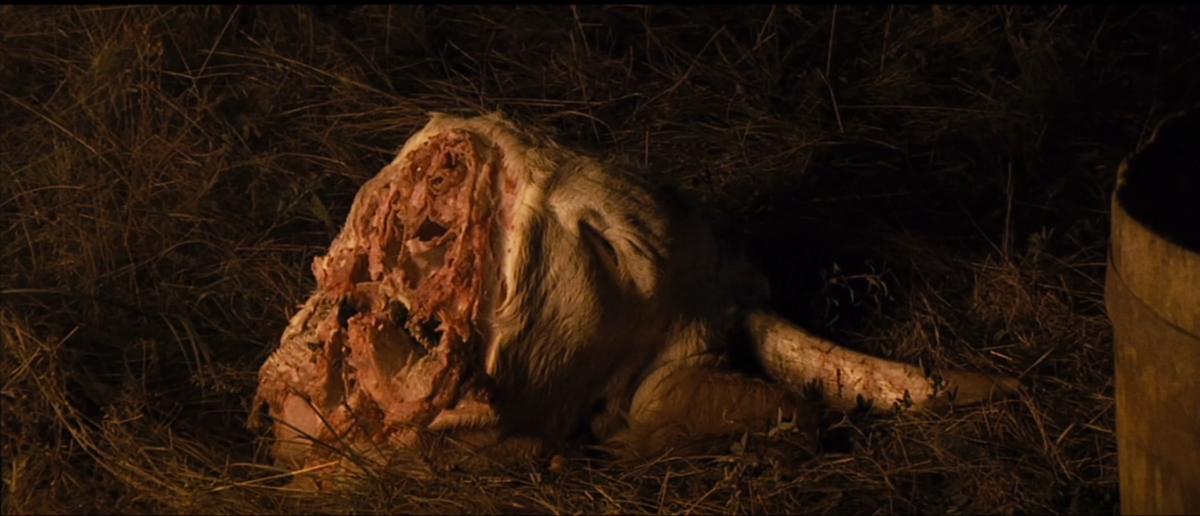While the production of Roberto Minervini’s docufictional What You Gonna Do When the World’s on Fire? (2018) and Albert Serra’s costume drama Liberté (2019) in the same short time frame is coincidental, their films embody a dialectic that might actually be innate to our contemporary cultural sensibility. This dialectical relation justifies an otherwise perhaps unfruitful juxtaposition between the committed Marxist and the decadent dandy. Minervini’s commitment is reflected in his democratic and non-exploitative approach: he documents the socio-political reality of marginalised minorities in the Southern United States by following a select group of protagonists for years on end, establishing a close collaboration. After portraying violent redneck masculinity, bible belt religiosity and extreme drug abuse, the director, in What You Gonna Do When the World’s on Fire?, turns his camera towards Louisiana’s Afro-American community, as embodied by two young boys, Titus and Ronaldo; Judy, a bar owner and performer; several members of the New Black Panther Party for Self Defense; and Chief Kevin, the leader of a tribe of Mardi Gras Indians preparing for the festival. The four occasionally intersecting narrative threads together demonstrate how racism continues to determine the lives of black people in the Deep South. This stands in stark contrast to Serra’s Liberté, a film that resolutely refuses to engage with contemporary social realities and furthermore offers no critical perspective on its source material. The Marquis De Sade adaptation shows how, after their expulsion from the court on the eve of the French Revolution, a group of libertines retreats into a German forest to live out their most perverse fantasies during a night of fornication and voyeurism. Liberté’s mesmerizing beauty is entirely beyond the ethical, seemingly turning back toward it with a mocking gesture. This tension between socially committed realism and self-absorbed formalism, and two aligned conceptions of history—progressive and reactionary, revolutionary and fatalistic, respectively—externalises a dialectic that is immanent in the oeuvre of Jean-Marie Straub and Danièle Huillet. In their Dalla nube alla resistenza (1978), they juxtapose an ancient, religious and a modern, revolutionary worldview, thereby delving into their common ground: utopianism. Beyond the dialectic of their distinct aesthetics, many other concerns constitutive of the tension between Serra’s and Minervini’s work are already touched upon in Dalla nube alla resistenza: the relation of present and past; opposed notions of history as fate and human progress and the aligned trope of sacrifice; the irreducibility of the material to the ideal and the related artistic preoccupation with the possibility of truthful representation. Ideas that, while already embedded in the work of Straub and Huillet, stretch out in two opposite directions in the aesthetics of Serra and Minervini, as if in reaction to the utopian discourses that haunt contemporary thought.
I. Dialectics
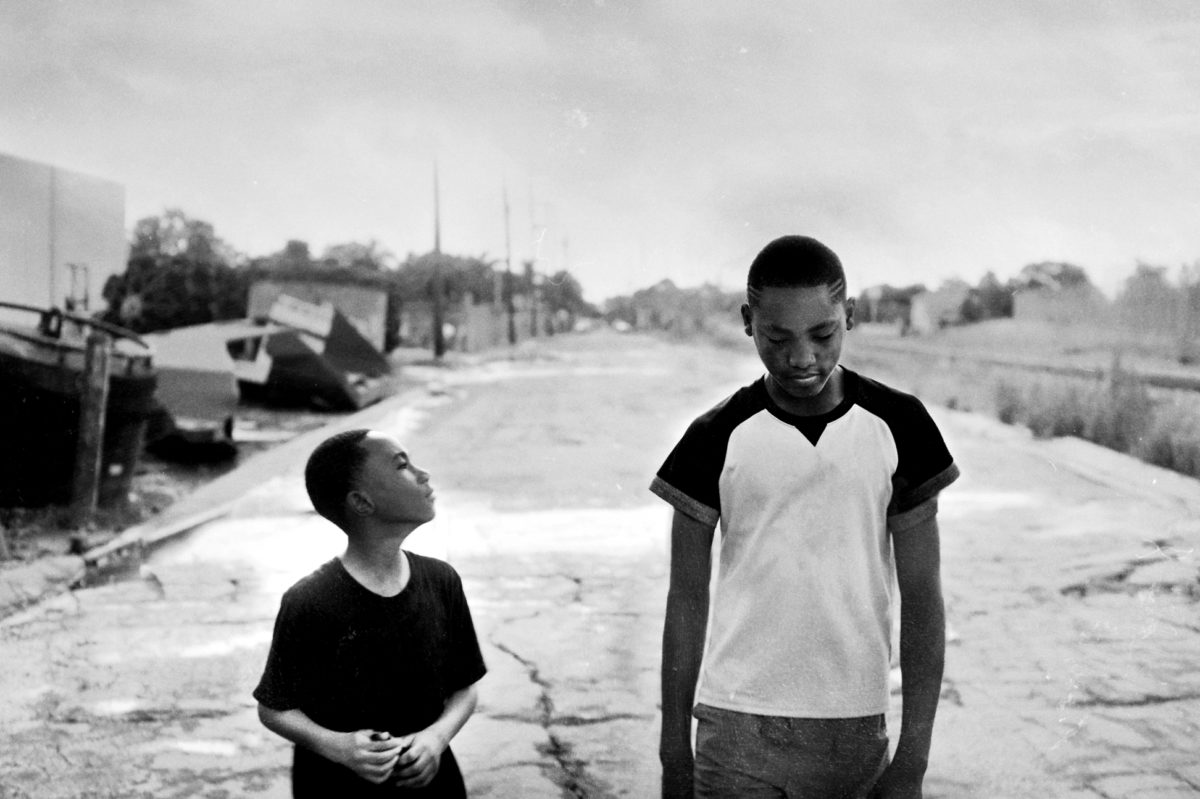
Although Liberté seems to illustrate nothing but ennui fostered by extreme wealth and privilege that fetishizes itself to the point of no return, its style goes beyond empty formalism, as the film’s static and slow pace conveys the inertia of its subjects. Its opening scene—showing a fatigued aristocrat napping in a wheelbarrow at magic hour—stands in stark contrast to the opening sequence of What You Gonna Do When the World’s on Fire?: a young boy, dressed up for Mardi Gras, shouts and dances through the streets of New Orleans, while the camera tracks his every move, Dardenne-style. Minervini’s camera is a dynamic one that minutely follows the movements of his protagonists, instead of tightly framing and accordingly restricting them. He imposes temps mort through more static, peaceful long shots, often of the young boys, Titus and Ronaldo, strolling along train tracks—moments of rest that syncopate the long scenes oversaturated with dialogue and might remind one of Edmund’s stroll through a destroyed Berlin in Germania anno zero (Roberto Rossellini, 1948). In Serra’s oeuvre, this dead time overtakes the entire film. We witness every situation—be it the process of dying or the enactment of sexual fantasies—with boredom, with the distance and lack of investment the removed, static camera inspires. The film thereby mimics the impotence embodied by its subjects, whose voyeurism rarely leads to anything beyond some disengaged fiddling with their flaccid penises. We never move, we do not follow any characters; we never leave the huis clos where the perversities take place.
This tangible stasis and removal pervades every level of Liberté: the viewer in a sense comes to share the subjects’ voyeuristic, narcissistic gaze that makes the other into one’s object—if they come into consideration at all. This solipsism is epitomized in one of Serra’s previous features, Història de la meva mort (2013), by Casanova’s (Vicenç Altaió) monologues, seemingly directed at no one, with listeners forming only a pretext for the narcissist to speak. What emerges from the subjects’ behaviour, is an unbridgeable removal from and objectification of alterity; an apathy towards one’s surroundings, towards reality. Serra’s films appear to be about talking into the void, while Minervini’s appear to be precisely about the attention directed toward the other—attention that is not without its own particular violence, as we’ll come back to later on. We witness people being initiated in a particular worldview, absorbing a particular ideology: Titus and Ronaldo get lectured by their mother in a shot-reverse shot construction that frames the lecturer from a slightly lower angle, her face almost filling out the screen. The reverse shot is held onto for a remarkably long time, with those lectured always remaining silent, eyes cast down, listening intently. This too, Minervini seems to have picked up from Rossellini’s Germania anno zero, in which the interiorisation of ideology is shown without an interior monologue. The impact of subject on subject, the closeness and willingness to listen, is evoked by the film in its entirety, through its lengthy shallow-focus close-ups, which draw us nearer, suggesting proximity to the protagonists.
What Serra’s cinema seems to bypass, is the confrontation with reality’s resistance to the imagination of the artist that French critics such as André Bazin and Amédée Ayfre identified in neorealism. This confrontation lives on in Minervini’s cinema because his documentary aesthetics is informed by an epistemological concern and an ethically motivated attention to exteriority: cinema must be subjected to a “moral question,”‘Roberto Minervini : “L’autre côté” de la société américaine’, https://www.franceculture.fr/emissions/la-grande-table-1ere-partie/roberto-minervini-l-autre-cote-de-la-societe-americaine. as the director claims (again in accordance with Rossellini’s conception of cinema). This is a point of conflict Serra avoids entirely by mostly steering clear of reality: in line with the literary sources he chooses to adapt, he completely abstracts from not only the contemporary state of things, but the broader historical context in which the source text originated. As such the only ‘real’ fact, the revolution briefly mentioned at the beginning of Liberté, serves as a mere pretext for the creation of a dictionary of sexual perversities. Reality is thus rendered mute, corresponding to the widespread scepticism towards the possibility of its representation. Minervini’s commitment to depict reality, on the other hand, should not be confused with a naive belief in its representability as such. He is well-aware of the lessons of the cinéma verité movement epitomized by Jean Rouch, and secondly, in accordance with the idealist tendency in Rossellini’s neorealism, he does not regard reality as strictly objective, but as informed by ideological structures, mythologies, sentiments, emotions, expectations and so on. While we’ll come back to the latter later on, the former was explicitly addressed by Minervini, who remarked that his ‘actors’ are extremely conscious of the camera’s presence and consequently adapt their discourse to be understood by a broader audience.Ibid. Minervini’s awareness of this resistance and the way it is incorporated in his work further nuances his position as a director, thereby contributing to a sense of reality, if only because it attests to a proper respect for the depicted. By contrast, Serra, in his avoidance of reality—in his use of cameras not to document, not to reflect on the reality the cinematic medium unavoidably captures to some extent—and in his choice to instead create something of the utmost artifice (something elitist, conservative, non-committed), appears as equally self-indulgent as his characters
At this point, our juxtaposition between the Marxist and the dandy might seem merely antagonistic and the poorer for it. We’ve illustrated a contrast with value judgements attached to its extremes: taking into consideration Minervini’s artistic engagement, Serra’s work might appear as unjustifiably decadent and solipsistically impotent—precisely the type of art our tumultuous times do not need. On the other hand, socially committed art is itself in no way exempt from potential ethical perversion. The identification meticulously evoked in Minervini’s cinema through the use of close-up and extreme shallow focus could be considered equally questionable, given that it blocks out the impoverished environments that could rupture the sought-after cinematic beauty and seems to communicate a naive belief in the approximation of alterity: it creates an illusory identification with a slice of society whose suffering we may be unable to comprehend. Their marginalisation is not magically resolved; the distance between viewer and subject not spontaneously abridged. Shouldn’t one consider Serra’s use of long shots, with their distance and neutrality, which offer the opportunity to become disgusted and disillusioned with the scenes depicted (in accordance with our own values) in fact more honest and non-exploitative? Instead of venturing into the hazardous ordeal of depicting alterity, he displays the cul-de-sac in which Western civilisation has stranded. What those rejecting Serra’s cinema apparently do not dare to confront themselves with, is their own culture, instead preferring to gaze at alterity from a safe distance.
Approaching their aesthetics through this antagonistic logic—isolating them within the categories ‘art for art’s sake’ and ‘committed art’, respectively—leads nowhere. Better then, to wait out the emergence of some likeness amidst their differences, some aspect that draws a line between them: an axis that connects the supposedly unjustifiable decadence of the one to the respectable commitment of the other. One such similarity could be their focus on people in the margins of society: while Minervini focuses on marginalised and impoverished communities, Serra (at least in his last three films) follows an aristocracy in decline, from the death of Louis XIV to the French Revolution. This axis immediately brings us to yet another intersection: these extremities of society both await social change—in the case of the black community, anxiously; in the case of Serra’s decadent aristocracy, not even with the faintest interest. The today omnipresent twofold conception of revolution surfaces in Liberté and What You Gonna Do When the World’s on Fire?: a form of radicalism or even terror according to the ruling classes, who, lazily wallowing in their privilege, regard it as invasive and destabilizing, justifying police brutality accordingly, while desired and considered a moral imperative by the oppressed.
II. Revolution
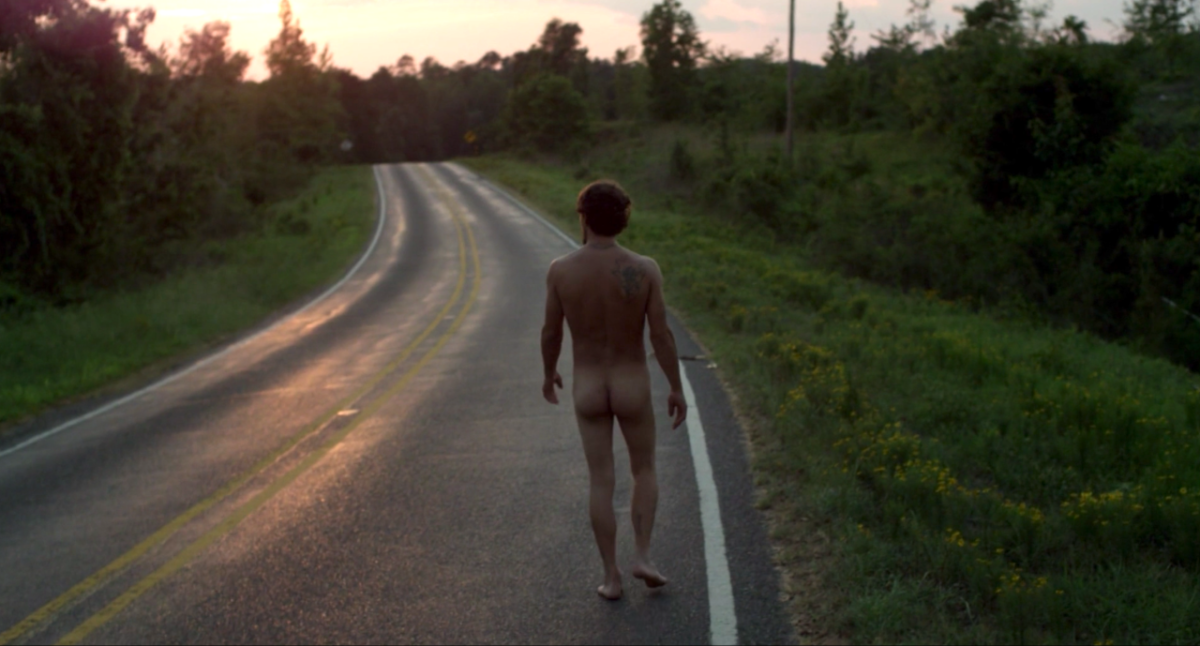
A title at the very beginning of Liberté situates us somewhere between Potsdam and Berlin in the year 1774. What follows is a serene though somewhat peculiar tableau: a man with a powdered face, wig and velvet costume, complete with delicate lace, is snoozing in a wheelbarrow in the forest as he awaits nightfall. Evening light sluggishly drapes itself over the landscape accompanied by the monotonous sound of cicadas. Similarly at sunset, Mark (Mark Kelley), a longtime drug dealer and addict and the protagonist of Minervini’s The Other Side (2015), dresses up in a costume and sets out into the woods. Light flecks travel across his face as we follow his course beneath the canopy of trees in a sequence of highly stylized close ups. Mark too is awaiting something, although it concerns a development of a more dignified nature: he is about to have himself arrested to start his rehabilitation. His solitary rite of passage culminates in his unrobing in a clearing, which, on a narrative level, betokens a return to the very first scene of the film in which Mark wakes up dazed and naked at the side of the road. (The film’s stylization, particularly in this scene, as well the cyclical narrative, attest to the inherent fictionalization in Minervini’s documentary aesthetics.) Furthermore, on a thematic level, the unrobing underscores a moment of envisioned rebirth. Whereas the aristocrat slumped down in the wheelbarrow exudes nothing but ennui, Mark’s solitary moment of contemplation radiates hope. The scenes, both moments of anticipation, are indicatively placed at quite different moments in the two films: in Marks case, it is a final scene which leaves us to wonder whether he’ll succeed at turning his life around, while the libertine’s magic hour scene is placed at the very beginning of an aimless narrative that will soon reveal itself as a dead end. These two illustrative scenes outline the tension between potency and impotence, between the possibility of change and resignation, hope and ennui, that resonates within the question of revolution.
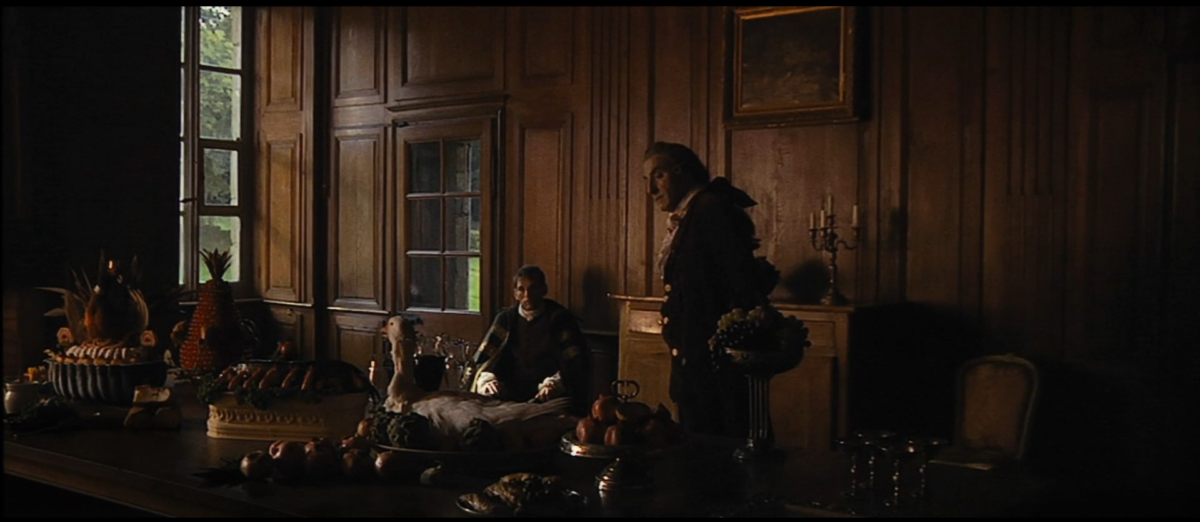
In Serra’s Història de la meva mort, Casanova passes his time wandering around his estate, devouring an exuberant amount of pomegranates—the amplified crunching sound becoming increasingly insufferable with every scene. While entertaining a guest, he follows up some misogynistic remarks with the statement that “those women will cause a rage in times to come.” His interlocutor somewhat anxiously inquires what exactly is going to come, after which Casanova responds (slightly withdrawn, though with his usual arrogance): “The revolution.” In his childish conviction of his own brilliance, he continues to illustrate his point by means of the extravagant meals (reminiscent of baroque still lifes) set out on the dinner table: picking up an eel just to slap it back on the table declaring that “heads will roll”; forcing the prepared goose into the arms of his confused, young guest, as he holds it by the neck and introduces it as the king (“r-oie, r-oie”) while announcing that France will fall. Although Serra resorts to humour where some might consider it inappropriate, the theme of revolution is introduced at the very beginning of this film and his meditation on it continues in Liberté. Throughout, the topic remains drenched in the impotence of the ruling class, that may foresee it but to no avail, and moreover without any investment in the matter—an aloofness aligned with a more general withdrawal from the possibility of a transcendent perspective. This stands in stark contrast to the conception of revolution as a divine mission, endorsed by Krystal Muhammad, chair for the New Black Panther Party for Self Defense in What You Gonna Do When the World’s on Fire?. The latter’s appeal for political and societal change, given the godforsakenness of their circumstances, the overwhelming proportions of what they are up against—structurally embedded social injustice appearing almost as a vis major—in turn requires a belief and determination that becomes quasi-religious. A comparable marked conviction of one’s capacity for change and the possibility of solidarity is noticeable in Mark and the other protagonists of The Other Side, for whom the hope for societal progress stands in close relation to a religious worldview.
One could wonder whether a similar alignment of belief and resistance is meaningful, since the former is often regarded as an obstruction to the latter. Straub and Huillet’s Dalla nube alla resistenza, the title of which Straub paraphrased as “[f]rom the clouds, that is from the invention of the gods by man, to the resistance of the latter against the former as much as to the resistance against Fascism”‘Dalla nube alla resistenza’, https://www.sabzian.be/film/dalla-nube-alla-resistenza., explores this dialectic in a fascinating way. The first part of this diptych is constituted of various scenes set in ancient history which concern fate, destiny, the gods and a related cyclical conception of time, while the second is set in the present time and, as opposed to the fatalism conveyed in the former, is embedded in a modern understanding of the human capacity to intervene in the course of history; the capacity to resist, to revolt. What proceeds is a gradual dissolution of the disjunction between these two worldviews, which is already present in the film’s source texts for its two respective parts: Cesare Pavese’s Dialoghi con Leucò (1947) and La luna e i falò (1950). Straub and Huillet’s desire to dialectically reconcile two subsequent and opposing frames of reference (the mythological and the enlightened) might explain their fascination with Hölderlin—who, a few years on, will provide them with the source material for Der Tod des Empedokles; oder: Wenn dann der Erde Grün von neuem euch erglänzt (1986)—as the young writer was entirely impassioned by the French Revolution and convinced of the human potential for change, even as he was feverishly devouring the Greek literature and philosophy in which destiny reigns supreme. Although the literary source text cannot easily be recuperated as an outright form of activism, Straub and Huillet were convinced that Hölderlin’s text already preached nothing other than revolution and considered their adaptation to revolve around “a communist utopia”.Danièle Huillet – Jean-Marie Straub. Writings. Edited and translated by Sally Shafto. New York: Sequence Press, 2016, p. 212, respectively, p. 204: “Hölderlin dreamed of the revolution (…) a revolution that did not take place. (…) This dream, this utopia, is two hundred years old today and, one has to observe, more current than ever.”
While utopianism—the connective tissue that warrants the aforementioned alignment of belief and revolution—is present in the work of both Serra and Minervini, they have very different approaches to the matter. When asked about the view on the future implicit in his film, Minervini stated that he does not bolster pessimism, as it is as a reactionary form of thought.‘Roberto Minervini: “Je refuse qu’on dise qu’un film est pessimiste”‘, interview 30/11/2018, https://www.franceculture.fr/emissions/par-les-temps-qui-courent/roberto-minervini The goal of his cinema is to create awareness on a particular issue, thereby working toward progressive societal change. This conception of reality and history is determined by his Marxist worldview. Liberté, in turn, (however far removed it might appear from any utopian ideal) according to Serra concerns “a utopia of sexual liberation, with no difference between people: no women or men, servants or masters, handsome or ugly people. A perfect yet strange, dark utopia: a total fraternity of bodies.”‘Freedom: Albert Serra’, with Flavia Dima, 03/07/2019, https://mubi.com/nl/notebook/posts/freedom-albert-serra However, the proposed sexual revolution immediately reverts into a form of melancholy, in accordance with Serra’s implicit understanding of history, which appears to be of a late Hegelian nature. Philosophy—understanding, knowledge—is only possible after a historical period has come to an end, Hegel famously argued, leaving humanity subjugated to the course of history (which he moreover considers to be rational and necessary, no matter the amount of human suffering it generates).G.W.F. Hegel, ‘Grundlinien der Philosophie des Rechts’. In Werke. Band 7. Frankfurt am Main: Suhrkamp, 1986, p. 28 [first published 1831]: “Wenn die Philosophie ihr Grau in Grau malt, dann ist eine Gestalt des Lebens alt geworden, und mit Grau in Grau lässt sie sich nicht verjüngen, sondern nur erkennen; die Eule der Minerva beginnt erst mit der einbrechenden Dämmerung ihren Flug.” Translation: G.W.F. Hegel, Philosophy of Right. Translated by S.W Dyde. Kitchener: Batoche Books, 2001, p. 20: “When philosophy paints its grey in grey, one form of life has become old, and by means of grey it cannot be rejuvenated, but only known. The owl of Minerva takes its flight only when the shades of night are gathering.” For a more detailed account, see Hegel’s Lectures on the Philosophy of World History. In the light of a similar conception of history, commitment is meaningless. Serra’s libertines witness the end of an era and come to the realisation that their ideals are impossible to spread. At this point beyond recuperation, the depicted decadence “is something that touches a sort of a broken dream… In this impotence, [the libertines] create a smaller world that is at the beginning of the world,” Serra explains.‘Freedom: Albert Serra’. Cf. “There is also the moral decadence, the desperation, when you realize that none of these dreams are actually possible and you give up, you become desperate, cynical.”
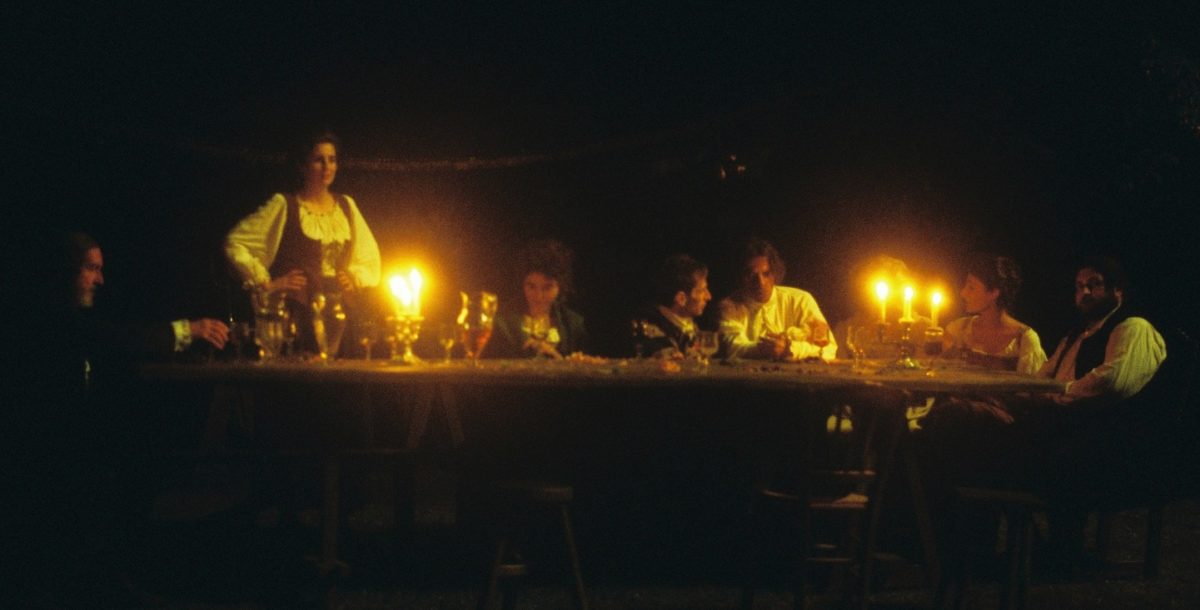
Despite Minervini’s clear commitment to represent contemporary reality, it would be a misconception of enormous proportions to believe that history does not play a role in What You Gonna Do When the World’s on Fire?. In one of the discussions at Judy’s bar, she asserts that fear “is in us”, that it is “bred”, handed down from generation to generation, after which the crowd nods and chimes in in agreement. Even the conversations between the children (Titus and Ronaldo) demonstrate an acute awareness of the consequences of not only skin colour or race, but also the terminology, the discourse surrounding the question of race. Minervini gradually reveals how the present of these people is fundamentally structured by the past, to such a degree that one cannot separate past and present without losing one’s capacity to comprehend the latter. Within his aesthetics, this peculiar temporality becomes manifest as he closely follows the acts of his protagonists, giving centre stage to their everyday discourse. At the same time, while Serra brings a historical adaptation, it cannot rightfully be said that he is inattentive towards the present. Liberté, he states, “is shot in our days, the utopia of the sixties is no longer in the soul of the people.”Ibid. The statement links his treatment of the French revolution (preaching liberty for all citizens though in fact of course excluding women and inhabitants of the colonies), to the sexual revolution of the 1960s (prophesying sexual liberty), which, similarly, failed to fulfil its promises. This accumulation of failed (and often already dubious) attempts at equality and liberation naturally reverberates in our present. Hence, Serra’s historical adaptations are concerned with the present—or at least a far more recent past—just as Minervini’s radical attachment to the present is actually a reflection on the country’s history.
III. Sacrifice
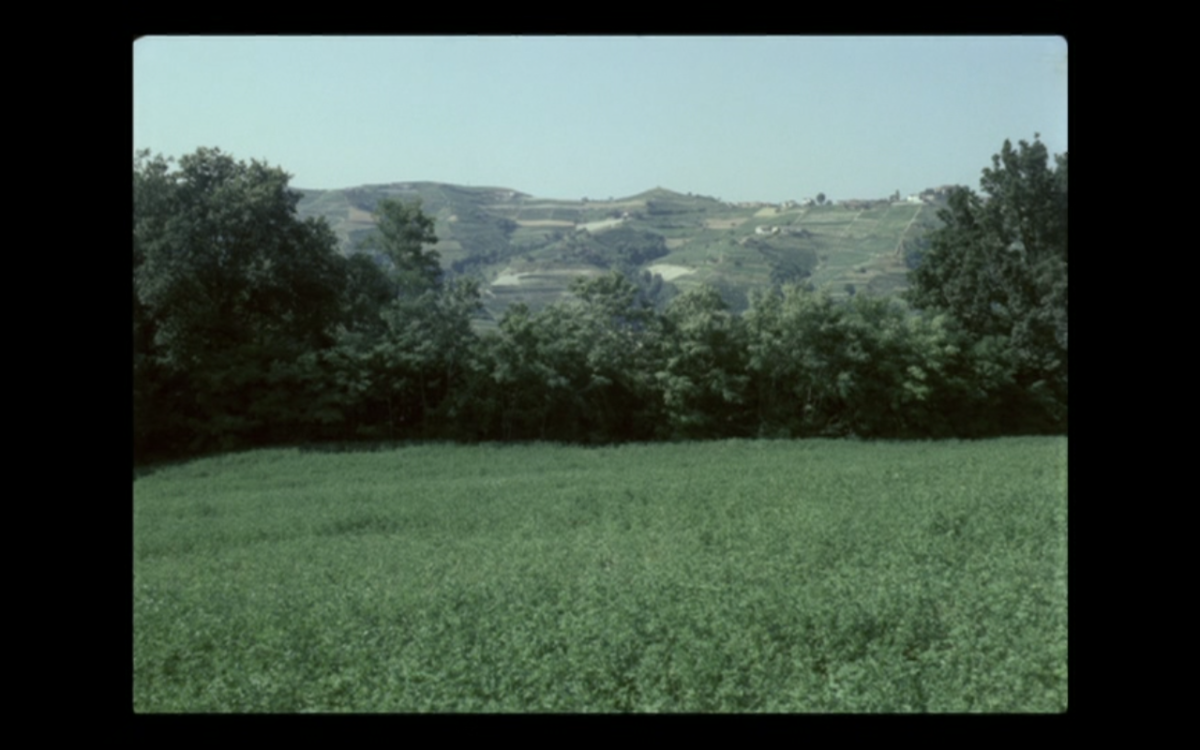
“Wo keine Götter sind, walten Gespenster,”Novalis, Werke in einem Band. Berlin: Aufbau-Verlag, 1983, p. 342. Translation: “Where there are no gods, ghosts reign…” in Novalis, Philosophical Writings. Translated and Edited by Margaret Mahony Stoljar. New York: State University of New York Press, 1997, p. 148. wrote Novalis, an early German Romantic, in the wake of the French Revolution. These ghosts turned out to be fascism and communism: new forms of mythology that replaced religion (heavily criticized as it was by the enlightenment philosophers) as the framework through which the individual seeks a meaningful relation to her environment. Straub and Huillet must be situated in this context, given their vehement rejection of fascist thought, and their endorsement of a new communist utopia, radically distinct from a form of state politics, and inspired by Hölderlin’s revolutionary play that was also written in the wake of the French Revolution. Their work is a meticulous attempt to grasp reality by deconstructing the ghosts, the mythologies, even as they acknowledge their constitutive role in society. With this incentive in mind, they adhere to a radical asceticism, as opposed to the aesthetics propagated by the culture industry that blindfold spectators and lull them with pleasant dreams, instead of driving them to re-learn to see reality. In Der Tod des Empedokles, Straub and Huillet’s rather hermetic formalism, characterized by stasis and substantial amounts of text delivered with more attention for the musicality of language than readability, renders Hölderlin’s often archaic language even more elusive. While their style does not make for an art that is in any obvious way inclusive or democratic and, accordingly, seems to clash with the more realist impulse often associated with committed art, they aim for an emancipatory effect by engaging viewers in their deconstruction of society’s mythologies. A fascinating observation included in their work is that the deconstruction of existing mythologies within a revolutionary logic might demand sacrifice, epitomised by the messianic figure of Empedokles, who kills himself at the height of his idealism, in the wake of the disappearance of the Gods; it is an obviously religious trope lying at the origin of man regarded not as mere ‘enlightened’ animal rationale, but as the animal that is able to foresee and lament death.
Sacrifice cuts accros the two parts of Straub and Huillet’s Dalla nube alla resistenza. In the first part, based on Pavese’s Dialoghi con Leucò, several characters are punished by the Gods for their misbehaviour, as is the case with Lycaon, who is transformed into a wolf after a sly attempt to feed Jupiter human flesh to test his divine powers.That is how the myth is told in Ovid’s Metamorphoses, Book I, verses 209-239. In another dialogue, a stranger, Heracles, visiting Lityerses’ farmland is told that he will be sacrificed because the earth needs blood to guarantee a bountiful harvest the following year. Pavese gives this dialogue a rather surprising Marxist twist, similar to the one in the final dialogue, in which a father, who has lit a bonfire to beg the gods for rain, says that nowadays the masters are the “heatwave […] and no rain can liberate us from them.” This scene, straining under a vast amount of dialogue, is crosscut with shots of fields abounding with wheat. Straub and Huillet’s reliance on materiality at pivotal moments of the film is made even more explicit in the last scene of the contemporary part of the diptych, in which Nuto, in close-up, tells the story of a young woman, Santa, who got involved with the partisans and allegedly betrayed them. After being sentenced, Nuto says, she tried to escape and was shot in the back, on a field surrounded by acacias. A harsh cut brings us a calm field where wind is rippling the treetops. There it was, so the narrator tells—the tranquil image remaining unaltered—that they covered her body with branches and set it on fire. The scene clearly articulates one important way in which the adaptation followed its source text, of which Italo Calvino noted: “Revolutionary history and this mythical, ritual anti-history have the same face in this book, speak with the same voice.”Italo Calvino, ‘Pavese and Human Sacrifice’. In: Why Read the Classics? Translated by Martin McLaughlin. London: Jonathan Cape, 1999, p. 263. Within both perspectives on history, the idea of sacrifice plays an immanent role.
As a broad cultural phenomenon, sacrifice can be understood as mediating between the ideal (religion and/or ideology) and the real (the material and socio-economical base of society). It re-emerges consistently in the human relation to the real, as a means of negotiating with that reality, as a mythological response to dreadful circumstances. Sacrifice brings the ideal down to earth, tries to impose its materialization, as in the case of Edmund in Germania anno Zero, who kills under influence of the fascist ideology, or Lityerses, who wants to shed Heracles’s blood to improve the harvest. For the Black Panthers as well, personal sacrifices are expected for the greater cause. Consider, for instance, the scene that shows an initiation of new volunteers. Despite her rejection of the possibility of a promised afterlife, Krystal Muhammad speaks of a “divine mission”, and declares that the envisioned revolution demands the sacrifice of the volunteers’ personal liberties. This is to be understood in its most literal sense, as the protesters frequently get arrested and suffer police brutality. However, as a formative function within the community, within the context of ritual practices, the role of sacrifice reveals itself in more modest forms. A young girl, who is part of the Mardi Gras Indian tribe, cries out in reaction to the sting of a glue gun as someone is attaching feathers to her uniform, after which a woman playfully reproves her and gets her to chant “no pain, no gain” throughout the rest of the sartorial operation. The gain in this case being her participation in the Mardi Gras festivities, by which she inscribes herself into the redemptive mythology it carries out. Over the course of an entire year, Mardi Gras Indians, such as Chief Kevin, work on their costumes for the festival, inspired by Native American attire. Close-ups of their ritualistic work—the patient and elaborate embroidering of enormous amounts of fabric and headdresses, accompanied by work songs in a highly particular vernacular—interweave the other narrative lines in the film, and work up to its final shot. Through this work, this slow and meticulous adding of embellishments, shown in extreme close-ups of cloth, pearls and feathers, they are inscribing themselves in a broader ritual practice that implies resistance towards reality—towards earth, towards matter, towards death—while highlighting the possibility of hope, change and emancipation. The idea of liberty is equally enmeshed with sacrifice as it appears in both of its manifestations: as promised by revolutionary history and mythical-religious anti-history.
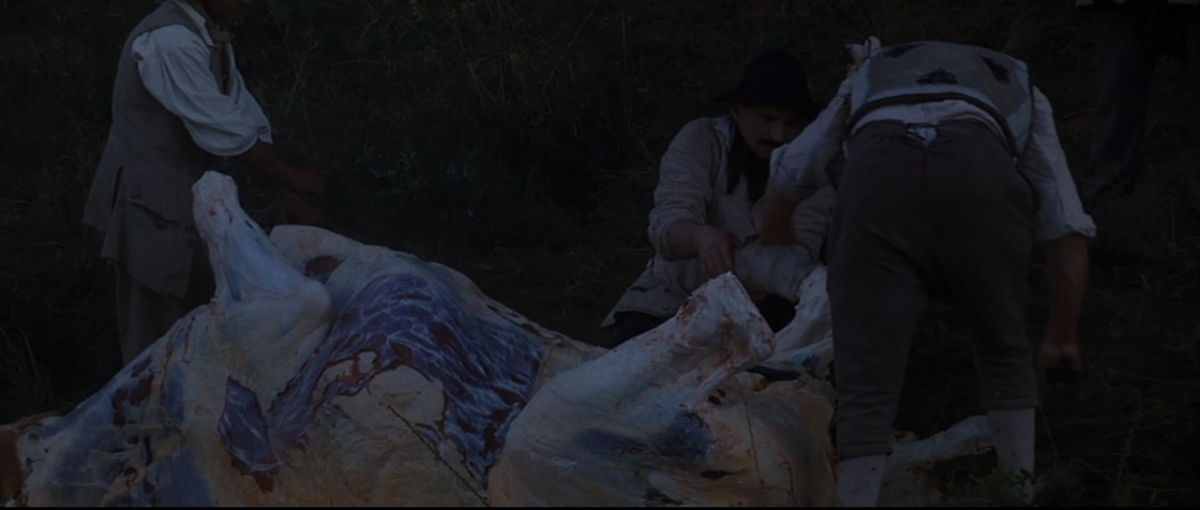
In Serra’s world of degeneration and apathy the trope re-emerges, despite the aristocrats’ apparent removal from any notion of transcendence and lack of necessity to negotiate with their material conditions. After a man dies during their night of debauchery, his limp body becomes attractive to the libertines, only for them to finally come to the realization that even the sacrifice of this ‘real’ material body proves insufficient to wrest oneself out of an ossified apathy. Casanova finds himself in a similar confrontation with death when he attends a sacrificial ritual somewhere in the Carpathian countryside, far away from the courts and salons where he conversed with major Enlightenment thinkers and moving closer and closer to the limits of rationality. The scene opens at twilight with a long-shot of an ox in the process of being skinned and gutted. In the scarce evening light, the white inside of the hide shimmers. Where the skin is stripped away, marbled blue muscle emerges, overgrown with thick yellow patches of fat, that overtake the clean surface with their almost mosslike texture. With puckish solemnity, Casanova asserts: “We are done with allegories,” and, while walking away with his servant, proceeds: “This is reality, eh? The smell of blood. It has a remarkable presence.” Suddenly, Serra cuts to a medium-shot of the skinned carcass as one of the skywards-pointing legs is being cut off, juices splattering about. Long shots of observers are intercut with visceral close-ups: one of the butchers chops off the ox’s snout, which is thrown in the bonfire, after which the discarded snoutless head is shown in the fire’s warm, ceremonial glow. Despite Casanova’s abhorrence of religion, he appears moved by the gory ritual itself, which Serra communicates by stressing the irreducibility of flesh, of matter, showing it again and again as that what lies entirely beyond the grasp of words. It is this same rumination we appear to stumble upon in Straub and Huillet’s masterpiece Dalla nube alla resistenza. That which lies beyond words is the ‘real’; the rock Tiresias speaks of in the third of the Pavese dialogues. What is sought is the thin line between materiality and ideality; their resistance towards one another and the romantic myth of their union. This is made manifest when, after endless discussion on the topics in question, Straub and Huillet suddenly make us see the fields abounding with wheat; the wolf awaiting death stretched out on a boulder; just as Serra makes us see the ox’s snout smouldering in Història de la meva mort. The thin line between life and death, as it becomes present in sacrifice, is caught in ‘ein himmlisch Licht’, a sheen of transcendence, because of the overall rituality in the scene, the viscerality of the images, the temps mort within which it’s encapsulated. It suggests, as Casanova indicated, a potential end of allegories: in the space unsealed by their withdrawal—in the wake of clouds lifting—the ‘real’ that man seeks in sexuality and death might be touched upon.
While the viscerality of death is actively sought out in both Història de la meva mort and Liberté as an attempt to transcend the all-encompassing ennui of the subjects’ existence, death imposes itself daily onto the protagonists of What You Gonna Do When the World’s on Fire?, to the extent that its accompanying rituals disappear entirely. Instead of the fetishisation present in Serra’s work, a certain necessary pragmaticism follows as a reaction to death; around the corner five people get shot, a fact that is recuperated by the mother of Ronaldo and Titus as an argument to return home before the streetlights come on. After a black man’s head is found on his porch, the Black Panther Party for Self Defense launches an investigation, given that the police classifies it as gang violence, despite the graffiti that appeared all over the neighbourhood during the same night: ‘KKK’, ‘negroes’ on a primary school signboard, swastika’s on trees and the car of a black deacon.
The image, the scene of the crime, incorporates written language that attests to the white supremacist ideology behind the violence: we are left with concrete traces of violent mythology as it pervades everyday life. Whereas in the last scene of Della nube alla resistenza, Straub and Huillet rely on an aesthetics of negativity in which the narrated violence, unrepresentable, superimposes an image of an empty field, we are here confronted with the materiality of a crime scene (rare close-ups of the environment, in this case the trunk of a tree, a timeworn signboard) in which traces of both the violent act and the ideology motivating it remain visible. In Straub and Huillet’s film, the dialectics of speech and image, of the ideal and the real, point to a radical gap: the landscape no longer shows traces of the violent event that took place. Only the story, only language, only remembrance remains. In Minervini, by contrast, the images of the crime scene surface as evidence, bring together the real and the ideal, the aggression and the motive. No matter the amount of stories and experiences shared in the film up to that point: the atrociousness of the racism endured fully materializes with these traces in which we see the primitive violence directed at the black community.
Unlike Serra’s libertines, who are restlessly attempting to break through a vast body of allegories and somehow touch reality, the people shown in Minervini’s latest film are desperately trying to break away from the death-ridden, violent environment they are condemned to. They want to move beyond a reality of decay (in the form of discrimination, violence, substance abuse, poverty, existential fear and self-destruction) through an ideal of community, through the creation of a shared ideology, new rituals such as those of the Mardi Gras Indians, through which redemption might be found. What both films reveal is the mythologisation of reality, in the form of religion, ideologies, hope, as well as racially motivated and sexual violence—a mythologisation which appears as an inherent aspect of human existence. In other words, this idealisation of the real is a consequence of subjectivity —it conditions its beauty and lies at the origin of evil—as Germania anno zero illustrates magnificently; good and evil, the clouds and every possible form of resistance, originate in this non-resolutory space of contradictions that is reality.
Conclusion
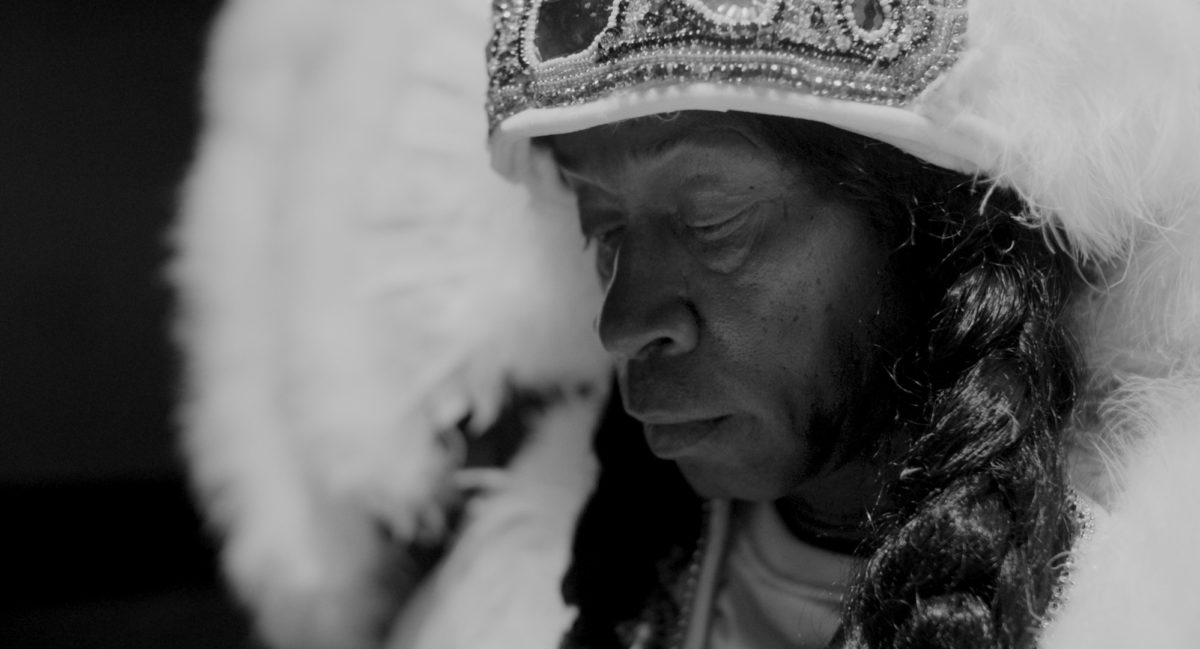
A concern with the present can be ascribed to What You Gonna Do When the World’s On Fire? and Liberté alike. Both contain a conception of history as that which underlies and informs the present. Serra depicts the late 18th century, while stressing the contemporary relevance of this undertaking; Minervini’s work, by contrast, is rooted in the present and uncovers how it is fundamentally informed by the past. The latter dismisses pessimism and propagates that people can exert influence on history; the former holds the defeatist belief that history blindly unfurls itself. Their respective conceptions of reality and history are dialectically related—a dialectic inherent to our present. Serra’s highly artificial representation acts as a funhouse mirror which blows certain aspects of life, particular social relations and attitudes, out of proportion, accordingly making the cul-de-sac in which Western civilisation has stranded, visible. Minervini, on the other hand, is a close observer of reality, approaches life with a magnifying glass, combing through hundreds of hours of footage to retrieve captured hushed subtleties in discourse, in movement, in sentiment, that attest to the presence of often violent mythologies in everyday life.
From this perspective, we can reconsider the value judgements attached to the aesthetic categories ‘art for art’s sake’ and ‘committed art’. Taking Serra’s work as an example, it becomes clear that its extreme aestheticization in fact can bring us right back into the domain of the political given that Liberté’s at first sight unjustifiable aesthetics is an inherent consequence of the implicit philosophy of history underlying the work. Arguments concerning Serra’s dubitable ethical point of view can be debunked since what he depicts is nothing other than the structures that have given form to our reality throughout history. The displayed mythology is violent, yet this is exactly what Serra is addressing, and what more wilfully ignorant critics—those perversely opting for the blindfold instead of the confrontation—apparently do not want to see. Such reductive views on the function of aesthetics also threaten Minervini’s work; one can only validly condemn his aestheticization of reality if one abstracts from the capacity of beauty to create an ethical stance towards reality. However, this would be contradictory to Minervini’s own stance with regard to the representation of alterity: “the search for beauty, for cinematic beauty” is imperative, he asserts, as he considers it his task to “render dignity and beauty to [the protagonists’] bodies and lives.”‘Roberto Minervini : “L’autre côté” de la société américaine.’ For Serra’s conception of beauty, see: Fireflies, Issue # 6, ‘Albert Serra/ Alain Guiraudie’, Berlin, October 2018, p. 71. & p. 101. Ethics and aesthetics are thus intertwined and what emerges is a continuum in which the borders between self-centred formalism and a committed stance towards alterity fades. A further consequence is that disputes concerning the unethical or abstracted fictionalization that supposedly differentiates fiction film from documentary are besides the point, since reality itself is mythologically structured. The line between Pasolini’s mythological and neorealist films is a thin one, an so, one could say, is that between Serra’s reproduction of mythology and Minervini’s reproduction of the mythology of everyday life. Reality is always already constructed by the word, by the ideal, and, as such, not accessible as pure reality – the utopia of absolute contact with otherness through the image stemming exactly from its impossibility. In spite of the fundamental entanglement of both positions, the role of art in contemporary society is still regarded along these two lines. Serra lucidly remarks that the current discourse on the arts denies the potential unabridgeability of the gap between complex, formalist art for an elite and easily understandable, democratic, socially engaged art, and aligns this with a “moral contradiction” in contemporary society.‘Freedom: Albert Serra’. In line with his adherence to a melancholic view of history, this denial of the possibility to overcome the gap between elitist and democratic art—in fact a denial of the possibility of a communist utopia, classless society—might explain why his work comes off as reactionary. If Minervini incarnates the progressive, revolutionary side of romanticism as it is omnipresent today, Serra incarnates its reactionary, melancholic side.
These filmmakers, however, not only deserve praise for addressing such pivotal issues (conceptions of history, reality, and art), but especially for how these themes are incorporated in their aesthetics. At the end of Liberté, for instance, we are shown a lengthy long shot of a part of the forest, while the light finds its way through the immense trees and dyes the dawn sky an astonishing cornflower blue. At first sight, it might be comprehended as a kind of redemptory epiphany, just as in Der Tod des Empedokles —of which the second title, Wenn dann der Erde Grün von neuem euch erglänzt, gradually becomes comprehensible—when, after endless recitation, an extreme long shot of a landscape (a plain, lustrous trees, a mountain in the background) is shown. The shadows of clouds traversing the sky darken the plain significantly, only to leave it flooded by golden sunlight moments later. This presumed aesthetic realisation of the unity between God, light, the ideal and reality, matter, the real—Hölderlin’s romantic dream that inhabits Straub and Huillet’s utopian communism—momentarily breaks through the extreme formalism of the film.Cf. Rancière: “So there is this aspect that can be qualified as materialistic. But, at the same time, this materialism recalls the dream of the Romantic era (and that’s due to their proximity with Hölderlin and German Romanticism), meaning to the idea of a world where there would no longer be on one side the intelligible world, thought, and law and, on the other, the visible world, but a world where a common law would be incorporated in the visible world itself and where there would no longer be any opposition.” (https://mubi.com/notebook/posts/politics-and-aesthetics-in-the-straubs-films). In Liberté, however, a streak of artificial light suddenly crosses the soft morning light, thereby lacerating the hope for unity that the frame initially seemed to herald and instead creating a non-resolutory space of contradictions in which day and night, reality and artificiality, enlightenment and romanticism, and so on, are held within the image. The artificiality of this scene stands in contrast with the last shots of What You Gonna Do When the World’s On Fire?: Minervini’s close-up of Chief Kevin, leader of a tribe of Mardi Gras Indians, in full dress for the carnival. The image—captured on location, haphazardly, a documentary act—arrests within its calm, the temps mort of the moment before the festivities, a superimposition of historical events, of historical suffering, of both African Americans and Native Americans. Within this same image, the suffering and loss recounted, is countered by the reinstitution of a new, actively pursued culture. Pain collides with hope, in beauty and perseverance, within the enormous spatiotemporal scope contained in this single frame. Only by drawing together these contradictions in its fabric, can the image account for a reality that is itself, due to its inherent mythologicity, a non-resolutory space of contradictions.
